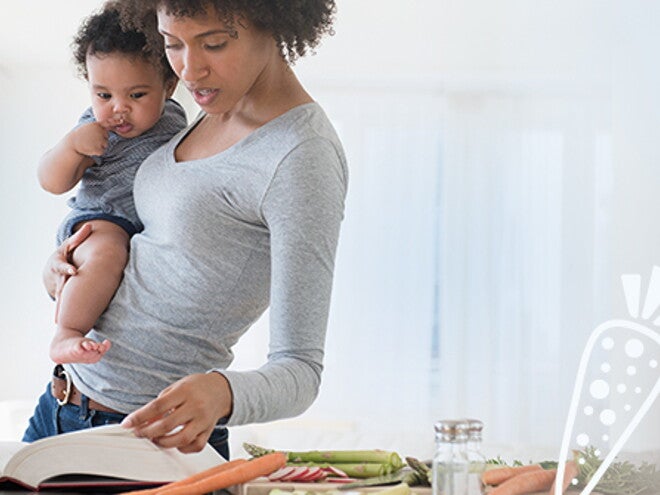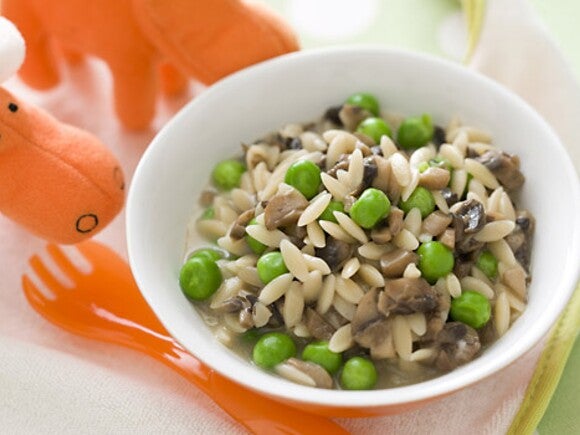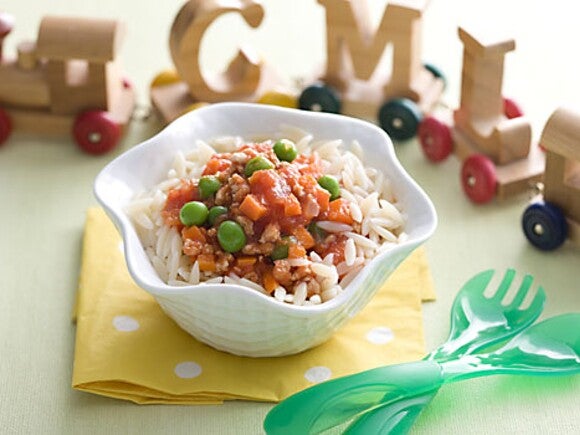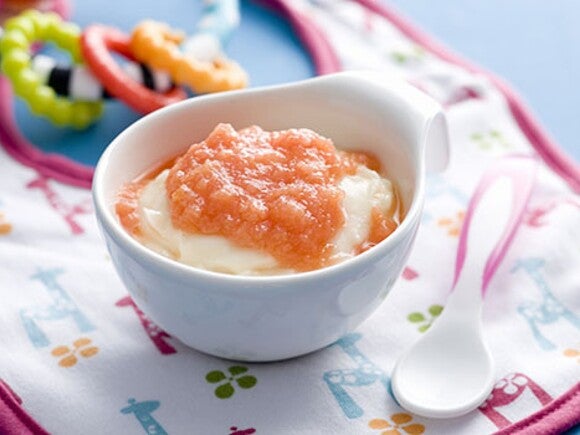As your baby grows and develops, they’ll be able to eat a wider range of foods. Introducing new flavour combinations to your baby’s meals can be fun and rewarding.
When introducing new foods, remember to keep an eye out for signs of intolerance and allergy. Although breast milk will remain your baby’s main source of nutrition until their first birthday, their menu can be expanded now. You can start offering combinations of foods once your little one has tried and mastered single ingredient foods. Exposing them to new flavours and textures now may make them more likely to eat new foods in the future, so get creative!
Thank goodness for fruits and vegetables
Fruits and vegetables are perfect for your baby because they are rich in important nutrients that support growth and development, including:
- Vitamin A—for eyesight and cell growth
- Vitamin C—an antioxidant that helps babies immune and brain function. Vit C also helps the body absorb iron when eaten at the same time as iron-rich (non-meat) foods, such as fortified baby cereal
- Potassium—a mineral that helps your baby’s nervous system and muscles work well
- Fibre—helps keep your baby’s digestive system healthy
Here are 10 tips for introducing new textures and flavours into your baby’s diet:
1. Don’t give up easily
Babies may need to try a food up to 8 to 10 times before they accept it. Your baby may make funny faces (or looks of surprise) when trying a new food, but it is often only because it is a food they haven’t tasted before. It doesn’t mean they don’t like it, or won’t like it. Even if your baby spits something out, don’t be discouraged, it doesn’t mean they will never eat that food. Be patient and offer it again the next day.
Foods that, at first, your baby doesn’t seem to like may become firm favourites after several tastes over a few days or weeks. Even a tiny taste (one small teaspoon) can help your baby learn to like a new vegetable. These flavours and textures are new, and your baby needs the opportunity to learn to accept and enjoy them.
2. Follow the morning approach
When offering your baby a new food, do so in the morning so you can watch for signs of intolerance or sensitivity over the day. If you suspect an allergic reaction, don’t give them any more of that particular food and seek medical attention straight away. Be aware that an allergic reaction is different to your baby spitting out food because the flavour or texture is new, or they’re full.
3. Make mealtimes social
Sit at the table with your baby while they are in their highchair. Smile, chat with them, and look into their eyes. Use simple words and an upbeat tone as you tell them “here comes a bite” and let them eat at their own pace. Making mealtimes a positive experience, and establishing healthy eating habits now, may last a lifetime.
4. Feed frequently
Babies have tiny tummies compared to adults, so make their portions small. Expect to eventually offer your little one three meals and two or three snacks per day.
5. Try traditional favourites first
Once your baby is eating a good source of iron, such as iron-fortified baby cereal or pureed meat, to help meet iron needs for healthy brain growth, don’t be afraid to then offer more variety of fruits and vegetables. Although the natural sweetness of apples, bananas, carrots, and sweet potatoes make them favourite first foods for many babies, try offering a mix of different tastes. Babies will accept a wide variety of fruits and vegetables, even those we think are bitter, and now is the perfect time to introduce these flavours.
6. Mix new with old
First try of a new taste? Combine it with a familiar favourite to help your baby learn to accept and enjoy it.
7. Eat a rainbow
Different-coloured fruits and vegetables contain different nutrients, so try to include a variety of hues in your baby’s bowl. This will give your little one the vitamins and minerals needed to grow and develop healthily.
8. Don’t forget dairy
Your little one can now have cheese and yoghurt, which provide calcium and important nutrients to help support teeth and bone structure whilst they’re growing fast. Look for plain, unsweetened yoghurts, or low-sugar yoghurts that have been specially designed for a baby’s nutritional needs.
9. Hold the sugar
There’s no need to add sugar when you’re preparing food for your baby, or to offer sweetened beverages. Fruit juice shouldn’t be introduced in the first year because of its relatively high natural sugar content. Pureed or mashed fruit has some fibre that juice will not, and your baby may likely eat this right up.
10. Stay hydrated
During their first year, breast milk is your baby’s main source of fluid, or infant formula if your baby is formula-fed. If anything extra is needed, it will be water. Try offering a little water (30-60ml) in a cup with meals and snacks. This will help your little one enjoy water as a drink of choice in the future, and as a thirst-quencher that isn’t sweetened.
Drinking water will help as they learn to move food around the mouth and swallow, as well as teaching them to drink from a cup. It’s important to know that cow’s milk shouldn’t be given as a drink until after your baby’s first birthday.
Is your baby ready for textured foods?
Once your baby is used to eating smooth, pureed foods, they may be ready for some foods with a thicker texture or small, soft lumps. Babies develop the oral motor skills for managing texture between 6 and 12 months of age. Their tongues learn to move solid food around their mouths so that it can be swallowed, and babies will practice moving their tongues side to side when eating more advanced textures with lumps. These skills are based on experience with texture. Here are a few ideas for introducing texture:
- try mashed banana or mashed avocado instead of pureed
- offer well-cooked scrambled egg
- add couscous, rice, or tiny pasta pieces to smooth purees
- prepare cooked or soft foods, such as carrots or sweet potatoes, using a hand blender (using short bursts), masher, or fork until you have a chunky, mashed texture
- add porridge oats to well-chopped soft fruit or low-sugar yogurt designed especially for babies
Sources
Australia New Zealand Food Standards Code - Standard 1.2.7 - Nutrition, Health and Related Claims (legislation.gov.au) https://www.legislation.gov.au/Details/F2013L00054






